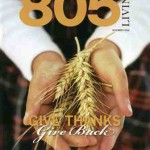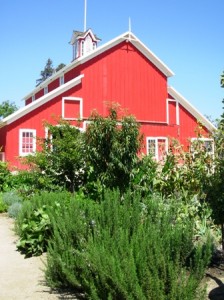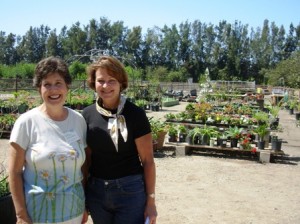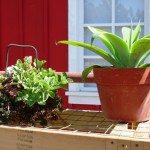Gifts from the Gardener
November 20th, 2008
 The month of November seems to generate an abundance of magazine articles about being “thankful.” For many of us, the notion of giving thanks is top of mind this season. Not only am I hugely grateful for my family, friends, home, garden and writing career, I’m so often reminded how rare these gifts truly are.
The month of November seems to generate an abundance of magazine articles about being “thankful.” For many of us, the notion of giving thanks is top of mind this season. Not only am I hugely grateful for my family, friends, home, garden and writing career, I’m so often reminded how rare these gifts truly are.
When it was time to write my “In the Garden” column for the November issue of my local magazine, 805 Living, my editor Lynne Andujar mentioned choosing Volunteerism as the month’s theme. You can see how nicely this idea is communicated on the cover, which reads: “Give Thanks, Give Back.”
The assignment made me think of Master Gardeners, some of the most volunteer-minded souls in the gardening world. I first learned about the MG program in the early 1990s, when my friend Jean Zaputil trained as a Master Gardener in King County, the local Seattle area program. I was always so impressed that Jean did this, especially when she managed the herb department for the local MG plant sales. That experience, combined with her BFA in Interior Design, soon led Jean to start her successful landscape design business.
Wanting to expand my own horticultural knowledge about the time I was trying to switch from business writing to home and garden feature writing, I applied to enroll in the 1998 Master Gardener class (also in King County). I spent many enjoyable years actively involved with the organization, including three years as PR chair for our annual plant sale.
When I moved to Southern California, I thought I’d re-apply and get in on the excellent training that comes directly from local horticultural experts. That’s when I discovered the Ventura County MGs require trainees to volunteer (“give back”) 80 hours of community service in their first year. The math just didn’t add up for me, at least at this time in my life. But the application and interview process introduced me to my local MG group, and piqued my interest in learning more.
What better way to get to know the Master Gardeners in my own back yard than by writing about them? (I always say that “I write in order to learn,” so it makes sense!).
 Thus, my visit this past September to Faulkner Farm at the Hansen Agricultural Center in the farming community of Santa Paula.
Thus, my visit this past September to Faulkner Farm at the Hansen Agricultural Center in the farming community of Santa Paula.
I met up with Diane Carter, co-chair of the local MG group and enthusiastic guide. At the heart of Hansen Center stands a big red barn, the iconic piece of architecture for anyone who loves growing plants that nourish us and provide pleasure to the senses.
With Diane as my guide, I toured the 5,000-square-foot teaching garden, which the Master Gardeners created. The “working garden” is now the centerpiece of training and public outreach activities.
The garden flourishes with fruit trees for the residential garden (avocado, persimmon, lime, lemon, fig, pomegranate, and more); roses (old-fashioned, damask, miniature, floribunda, grandiflora, and hybrids); common and unusual herbs; “square foot” gardening demonstrations; rock gardening; annual and perennial flowers; a vegetable patch; and theme gardens (including plants from every continent, a pollinator garden, a California native plant display, and plants for dyeing and weaving.)
 Like Master Gardeners around the country, the Ventura Co. folks take their volunteer commitment seriously. (At left, certified Master Gardeners Janna Calkins and Diane Carter).
Like Master Gardeners around the country, the Ventura Co. folks take their volunteer commitment seriously. (At left, certified Master Gardeners Janna Calkins and Diane Carter).
Among other projects, MGs staff a Help Line to answer home gardeners’ questions, support local botanical gardens and environmental education efforts, and teach the public using science-based horticultural knowledge.
As Diane put it: “I enjoy the ability to use my skills and gain new ones. When I come home at the end of the day, I feel good about my contribution.”
Here’s an excerpt from my interview with Ginny Winfield, an Ojai resident and special-education instructional aide, who uses her gardening skills to help others:
A soon-to-be graduate of the Ventura County Master Gardener program, Winfield partnered with the nonprofit Arc of Ventura County (which provides services to developmentally disabled adults) to teach gardening techniques to a group from Santa Paula.
“It was really nice to help people who never had an opportunity to learn about gardening,” Winfield says. The men and women came to Faulkner Farm, the MG demonstration garden in Santa Paula, and quickly embraced Winfield’s motto: If you take care of the earth, the earth will take care of you.
For her enthusiastic students, that meant weeding, pruning, and harvesting, among other activities in the edible and ornamental gardens.
“After tending the garden, they got to prepare the food and eat it,” Winfield says. The students enjoyed cooking – and tasting – fresh apple sauce, carrot juice and dried apples. They also designed containers of succulents and donated their creations to a MG plant sale.
Winfield is just one of about 100 Ventura County Master Gardeners who last year donated nearly 7,000 hours as “amateur experts” who teach science-based horticulture to home gardeners. Their volunteerism served 30,000 people last year alone.
“There is so much in the world where people are only sharing if they get paid, or if they get something out of it,” Winfield says. “I love the idea that this is a comradeship of like-minded folks who freely share gardening help. If you really want to garden and have an interest in sharing it, this is the way to go.”
 What’s better about gardening than sharing our knowledge and our experience with others? It’s a reminder we all need to hear.
What’s better about gardening than sharing our knowledge and our experience with others? It’s a reminder we all need to hear.
Ginny’s sentiments inspire me to find new ways to give back, especially in this time when so many have so little.









November 21st, 2008 at 10:33 am
from Liz Primeau’s engrossing, enthralling memoir- “My Natural History- The Evolution of a Gardener”
“This move is one we never should have made. Because they worked so well as a windbreak, the sturdy Austrian pines were favorites of highway planners at the time, and they looked so graceful around the cloverleafs we decided they would add some personality to our garden. Ours were cute little trees when we planted them, but in twenty years they engulfed the driveways and had to be limbed up; they retalliated by dripping sap over any car so audacious as to park beneath them.”
That’s one of the two steps. Once I get the thank yous out to the firefighters and some of the smoke filtered out of the air, I will get to the second part of the request. Doug Green is right. Anyone who has fallen in love with the feel and sweet smell of soil sifting between the fingers is going to LOVE this book.